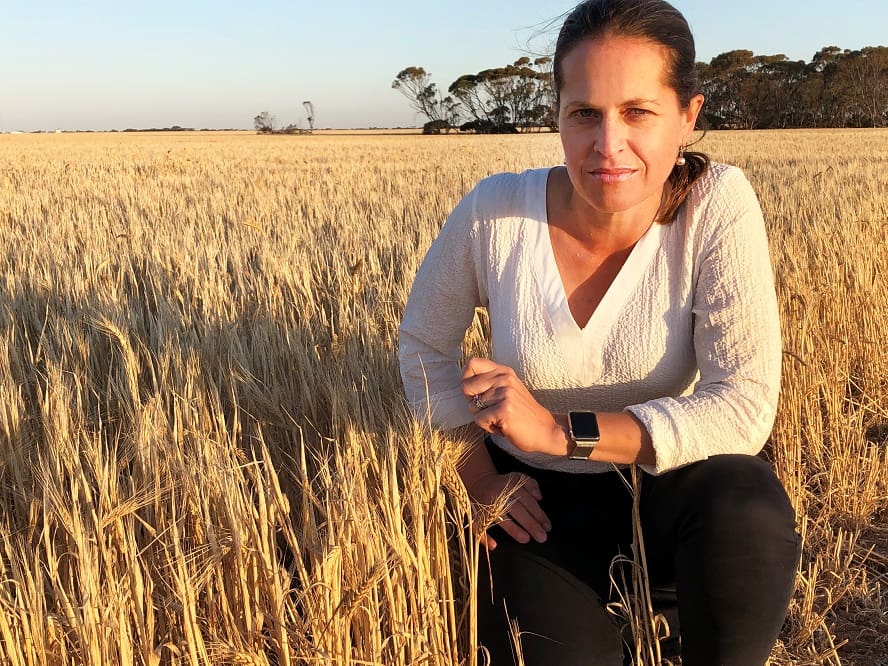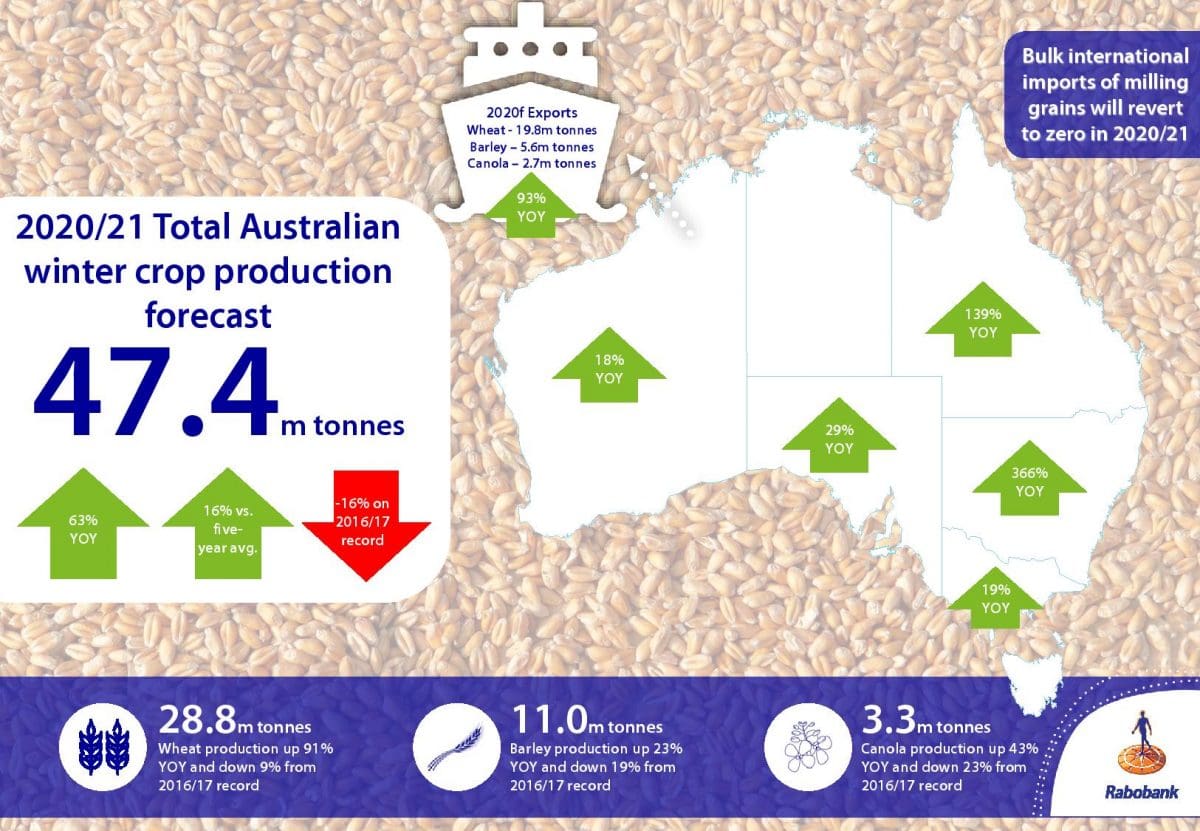AUSTRALIA is on track for a major recovery in grain production, with the winter harvest set to come in at above-average levels, according to just-released forecasts by agribusiness specialist Rabobank.
In its Australian Winter Crop Production Outlook 2020/2021, the agribusiness bank says after three successive years of below-average production due to drought in many parts of the country, Australia’s “long-awaited grain production recovery is here”, with the nation expected to harvest 47.4 million tonnes (Mt) of winter grains, oilseeds and pulses this year.
This is an increase of 63 per cent on last year and 16pc above the five-year average.
For New South Wales, it represents a staggering 366pc increase on last year’s harvest and for Queensland, 139pc – with all grain-growing states in Australia set to record an increase in production.

Cheryl Kalisch Gordon
“This increase not only represents a recovery, but also puts production back over average levels,” Rabobank senior grains analyst Cheryl Kalisch Gordon said.
“A 22 per cent year-on-year increase in planted hectares, together with well-timed and above-average rainfall in most regions, support our expectations for 28.8 million tonnes of wheat, 11 million tonnes of barley and 3.3 million tonnes of canola to be harvested in Australia in 2020/21.”
This will see Australia stage a major return to the global grains market, with Rabobank forecasting the nation’s grain exports to increase 93pc on last year.
And exports would be supported by a relatively-low Australian dollar (forecast to remain at around US70 cents in the year ahead) and comparatively-high global grains prices.
“The last time Australia had export volumes in these ranges, the Australian dollar was US10 cents higher and global grain prices were around 35 per cent lower than our current forecasts for the year ahead,” Dr Kalisch Gordon said.
“Both these factors will assist in moving these anticipated export volumes and support a good year for Australian grain farmers.”

From famine to feast
NSW would be the driving force behind Australia’s grain recovery in 2020/21, the report said, after being “the epicentre of devastatingly-low grain production in recent years”.
“NSW has gone from worst performer to best performer in just 12 months to lead the pack when it comes to grain production,” Dr Kalisch Gordon said.
“We expect a year-on-year lift of 12 million tonnes – a massive 366 per cent increase – in grain production in NSW, which would put the state’s harvest neck and neck with its record 2016/17 harvest.
“Seasonal conditions in NSW have been near to ideal and in stark contrast to recent years. Most production gains will be made in the central west, but above-average yields are also expected in the north and south of the state.
“All other states are set for an average or above-average harvest, with the exception of Western Australia. Here, a poor start and lower rainfall across the growing season means we expect a hit and miss year for WA and with the state’s harvest volume to come in above last year, but still 10 per cent below the (five year) average.”
Wet spring
The report said with a La Niña now declared active by the Bureau of Meteorology – for the first time since 2010 – and expected to deliver a wet spring, this would help finish crops and improve soil moisture in the eastern states, ahead of summer crop planting.
“Above-average spring rain will be beneficial, especially for regions that had a drier July and August, although the risk of a wet harvest – especially in parts of Victoria and NSW – is heightened,” Dr Kalisch Gordon said.
“Above-average rainfall during later spring does, of course, introduce challenges to harvest and the prospect of impact on quality. In areas that have already begun harvest, such as northern NSW, rain delays have already interrupted progress. This brings with it the real risk of downgrades to the quality of the grain which, if widespread, could have a substantial impact on the market due to the change in the quality profile of grain on offer.”
COVID concerns
The report said Australia’s grain sector had been able to proceed with an almost ‘business as usual” production year, despite the upheaval caused by COVID-19. And challenges related to the availability of harvest labour and contractors were also expected to be managed for the most part, with forward planning and work-arounds in place.
“Early season concerns regarding input availability due to COVID were managed so that there were no material impacts on production and, for the most part, we expect the same with harvest. However, the need to manage a wet harvest period without the typical labour force may deliver some regionally-significant production and quality downgrades,” Dr Kalisch Gordon said.
Market outlook
Notwithstanding the need to rebuild domestic grain stocks following drought, Australia is on track to export 19.8Mt of wheat, 5.6Mt of barley and 2.7Mt of canola this year, Rabobank forecasts.
While global wheat stocks are forecast to grow again by more than five per cent in 2020/21, the location of those stocks outside key exporting nations means global prices are expected to be supported, the report said.
“With a combined 15 million tonne year-on-year reduction in wheat exports from the EU and Ukraine this year, the world is looking to Australia’s recovery to help keep the market in balance,” Dr Kalisch Gordon said.
The bank forecasts CBOT wheat to trade around US580 cents/bushel over the coming 12 months, up 12pc year on year and approaching 40pc higher than 2016/17, when Australia last harvested an above-average winter grain crop.
“Despite supply renewal in Australia, we expect domestic prices to be supported by both global prices – which we expect to be near to 40 per cent higher than the last time Australia had an above-average harvest – and by an Australian dollar that is lower than 2016/17. This will keep prices in line with the five-year average and off the lows of 2016/17,” Dr Kalisch Gordon said.
Barley
With barley representing close to 23pc of this year’s winter crop harvest, 2020/21 is expected to be the second-highest barley crop on record (albeit still 19pc behind 2016/17).
Export opportunities for Australian barley are also very different to 2016/17, Dr Kalisch Gordon said, with China’s introduction of tariffs on Australian barley effectively ruling out significant volumes being sold to that market in the near term.
“Instead sales to feed-grain markets – such as Saudi Arabia, Japan and Thailand – will dominate Australian barley exports this year. This will mean pricing that is competitive relative to other origins of feed grain and at a discount to corn,” she said.
“These exports will also not replace the volumes that would have gone to China.”
As such, the report says, domestic barley stocks will grow this year, keeping local prices at a broad discount to wheat in 2021.
Canola and pulses
Despite an increased Australian canola harvest, Australian canola prices are expected to remain supported in 2020/21.
EU import demand for canola will approach record volumes this year – due to a significantly below-average European rapeseed (canola) harvest for the second year running – with Australia “in the box seat” to provide non-genetically modified canola (the European preference) to that market, the report said.
“We also expect Australian GM canola prices to remain supported in 2020/21, based on higher year-on-year pricing in the global edible oil complex more broadly and potential Chinese demand for GM canola,” Dr Kalisch Gordon said.
Cash or carry
After successive years of drought, the generation of cash flow would be critical for many Australian grain farmers this season, the report said,
“However, alongside this, there is also increased on-farm storage capacity among growers as well as the recent memory of high grain pricing due to drought, while interest rates are also at record lows,” Dr Kalisch Gordon said.
“With this in mind, we expect a large number of farmers will choose to carry grain, especially barley, into 2021.”
Source: Rabobank



HAVE YOUR SAY